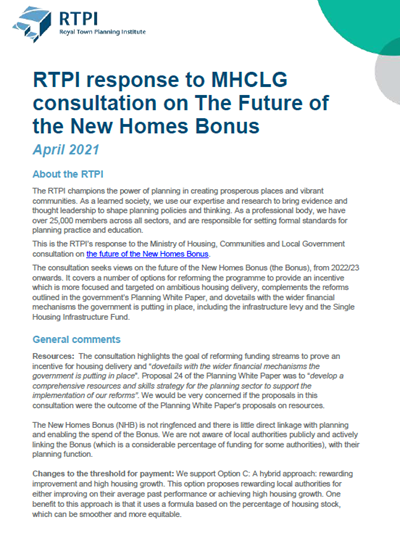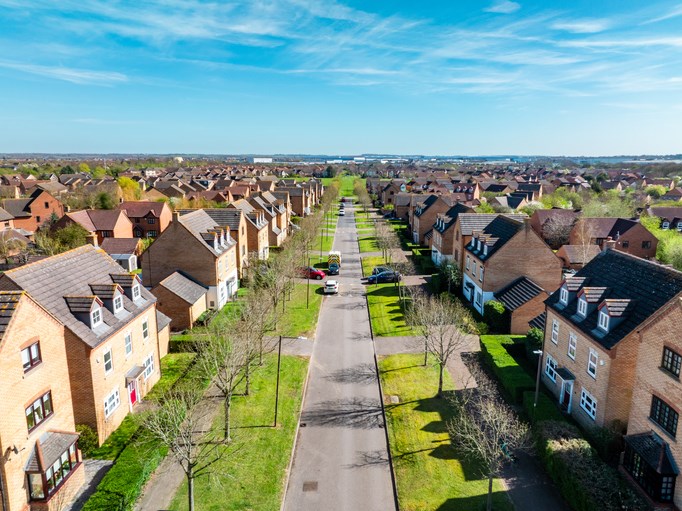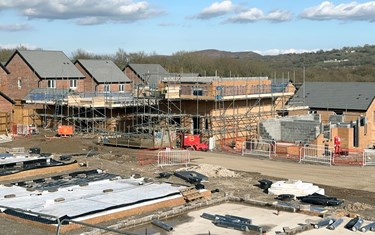RTPI response to MHCLG consultation on The Future of the New Homes Bonus
April 2021
About the RTPI
The RTPI champions the power of planning in creating prosperous places and vibrant communities. As a learned society, we use our expertise and research to bring evidence and thought leadership to shape planning policies and thinking. As a professional body, we have over 25,000 members across all sectors, and are responsible for setting formal standards for planning practice and education.
This is the RTPI’s response to the Ministry of Housing, Communities and Local Government consultation on the future of the New Homes Bonus.
Read the full response below or download it in PDF here.
 General comments
General comments
Resources: The consultation highlights the goal of reforming funding streams to prove an incentive for housing delivery and “dovetails with the wider financial mechanisms the government is putting in place”. Proposal 24 of the Planning White Paper was to “develop a comprehensive resources and skills strategy for the planning sector to support the implementation of our reforms”. We would be very concerned if the proposals in this consultation were the outcome of the Planning White Paper’s proposals on resources.
The New Homes Bonus (NHB) is not ringfenced and there is little direct linkage with planning and enabling the spend of the Bonus. We are not aware of local authorities publicly and actively linking the Bonus (which is a considerable percentage of funding for some authorities), with their planning function.
Changes to the threshold for payment: We support Option C: A hybrid approach: rewarding improvement and high housing growth. This option proposes rewarding local authorities for either improving on their average past performance or achieving high housing growth. One benefit to this approach is that it uses a formula based on the percentage of housing stock, which can be smoother and more equitable.
Multiple agencies: The NHB could be an incentive for a Local Planning Authority (LPA) to 'plan for growth' and achieve consents issued in a timely and efficient manner, however the LPA can sometimes only be a facilitator when multiple agencies are involved and those agencies might not be incentivised in the same way.
Incentivising behaviour: The proposals do not identify opportunities for financial incentives in addition to housing delivery such as to encourage meeting climate change and design objectives. We see this as a missed opportunity.
Linkages to proposed Infrastructure Levy: We are concerned at proposals to conflate the potential Infrastructure Levy with the Bonus. If the levy is notionally ring fenced for infrastructure spend, joining it functionally with the Bonus, which is a revenue “grant” for local authorities, may lose the opportunity to fund new infrastructure. We have previously expressed concerns about the effectiveness of the proposed Infrastructure Levy in providing sufficient resources to deliver infrastructure in areas of lower development value[1].
Not all completions are planning related: The NHB includes reward for homes delivered through permitted development which may not be supported by local authorities. This further removes linkages, apparent and perceived, with planning decisions and the Bonus.
Rewarding plan making: The Planning Delivery Grant, which used to be in place, is a good example. This was ring-fenced planning service revenue and awarded for key stages of local plans/core strategies. Smaller amounts were also awarded for other policy such as adopting SPDs. The awards were usually small, but it was a corporate highlighter of the importance of planning policy to support delivery. Such a scheme could be an opportunity for increasing delivery and plan making, but this would be most effective if it sat alongside NHB mainstream revenue funding.
The RTPI have set out the need for a Planning Delivery Fund of around £500 million over the four years between 2021-22 to 2024-25, which would direct investment into the priority areas including into Plan Making[2] and this could form part of fulfilling that need.
National parks: We recommend that the NHB be paid to National Parks and the Broads Authorities as LPAs directly, or that some formal mechanism is created which ensures monies are passed on to the LPA for the area where the new homes are built. The National Park and Broads Authorities are the only ten out of 337 LPAs who do not currently receive the NHB. It appears there was an oversight when the Bonus was introduced because the payment mechanism is linked to Council Tax collected by local authorities. National Park and the Broads Authorities are unusual in being LPAs but not local authorities and they were therefore excluded from NHB payments. If this omission were corrected to ensure that the NHB is paid to LPAs, it could be used by National Park Authorities for measures that are appropriate to local circumstances including, for example to support the delivery of local need housing.
4.1. Questions on the current New Homes Bonus
The efficacy of the current Bonus
Question 1: Do you believe that an incentive like the Bonus has a material and positive effect on behaviour?
No.
The NHB has not provided direct linkage with the planning service and has largely been integrated into local authority core revenue funding. To ensure a robust assessment of the impact of the Bonus, we recommend that government conduct updated research on the situation following the analysis conducted in 2014[3].
Question 2: If you are a local authority, has the Bonus made a material impact on your own behaviour?
No answer proposed for this question.
Question 3: Are there changes to the Bonus that would make it have a material and positive effect on behaviour?
A more immediate and ‘live’ grant linked to permissions, decision-making performance and plan making would have more of an impact instead of the way the NHB operates, which has quite a lag time.
The RTPI outlined our proposals for funding of LPAs in our submission to the Comprehensive Spending Review[4]. These proposals included the need for a Planning Delivery Fund of around £500 million over four years during 2021-22 to 2024-25, which would direct investment into priority areas including Plan Making4.
The legacy payments have the effect of smoothing funding over time, so the ‘live’ grant dedicated to the planning service could run as a single year performance bonus on top of the baseline NHB and legacy payment.
The split in two-tier areas
Question 4: Should the government retain the current 80/20 split in any reformed Bonus, or should it be more highly weighted towards the District Councils or County Councils?
County councils have in the past been a locus of strategic planning across multiple authorities, and at present the county councils support planning and development as a key infrastructure provider, including acting as the transport and education authority. The 80/20 split appears appropriate, but any additional Direct Planning Performance payment to Counties could be awarded for supporting Infrastructure Delivery Plans, Minerals Plans, or Strategic Settlement approvals, such as garden villages, where there is a significant infrastructure element.
The affordable housing premium
Question 5: Should the affordable housing premium be retained in a reformed Bonus?
Yes – to incentivise affordability.
We agree and support the retention on the basis that some affordable housing is essential. Affordable housing is required for the many lower paid but crucial key workers whom employers require to run local services and facilities.
Question 6: Is £350 per additional affordable home the right level of premium, or should this level be increased or decreased?
Increased for the same reason.
Although £350 per affordable home would appear a reasonable level of premium, we support a modest increase of £50-£100 per unit.
Empty homes
Question 7: Should a reformed Bonus continue to reward local authorities for long-term empty homes brought back in to use?
Yes.
We strongly support the need for empty homes to be occupied as they are a valuable source of additional housing to any community. This is particularly the case in more urban areas in which sustainable locations can have access to a wider range of local services and facilities.
However, we are not aware of any evidence in relation to the NHB vacant premium having a lasting impact on the level of vacant properties and the levels shift around a generally low level. We would like to see evidence or research conducted on this topic. This would also be helpful as establishing a baseline level of vacant properties has implications for housing market assessments and plan making.
Time period on which payments are based
Question 8: Should the Bonus be awarded on the basis of the most recent year of housing delivery or the most recent three years?
Basing the NHB on an average over [x] years could remove the cyclical nature and smooth the cashflow back to local authorities. The legacy payments have partly helped to smooth this out.
There are year to year bounces in completions and averaging out seems reasonable (and could align with 3 year HDT measures). However, some local authorities’ performance has been impacted by the introduction of Permitted Development Rights (office to residential in particular). If NHB were a reward for positive decision-making and those completions removed, this may also smooth out payments. However, this assumes the NHB were to function as a genuine performance reward, rather than a method of core revenue funding.
4.2. Changes to the threshold for payment
Option A: Raising the baseline percentage
Question 9: Do you agree that the baseline should be raised?
No.
Question 10: If the baseline is to be raised, should it be raised to 0.6%, 0.8% or 1% of housing growth since the preceding year?
The target growth has to be achievable in order for the NHB to remain an incentive.
Question 11: Why should the government opt for the baseline you have recommended in answer to the previous question? A higher baseline could potentially be combined with a higher payment rate (so as to keep the total level of funding broadly constant). Alternatively, the same payment rate could be maintained (in which case total funding would fall).
A higher baseline would be some reward to those LPAs seeking to address the specific housing needs in their local communities.
Question 12: If the baseline is to be raised, should this change be combined with higher payment rate?
Yes – to ensure the NHB remains an incentive.
We would support a higher payment rate being combined with a raised baseline.
Option B: Rewarding improvement: setting the payment threshold by reference to a local authority’s past performance
We do not understand how the concept of “improving delivery rapidly” when the basis is a multi-year average. We would also highlight that delivery may be a result of market forces and outside the control of the LPA.
Question 13: Should the government adopt a new payment formula for the Bonus which rewards local authorities for improvement on their average past performance with respect to housing growth?
No.
Question 14: If the government is to adopt such a payment formula, above what percentage (x%) of average past net housing additions should the Bonus begin to be paid? In other words, what should the value of x be?
Rather than a percentage increase in average housing delivery, we would suggest measuring average delivery net additions as a percentage of housing stock. This makes the target more meaningful and will create a more predictable outcome.
Any bonus for increasing the net housing additions should be a minimum of 5%, possibly increasing on any annual basis by perhaps 1% per annum if further additions meet certain levels of supply in meeting local housing requirements.
Question 15: If the government is to adopt such a payment formula, over what period should the annual average of past net additions be calculated? Should it be a period of 5 years or 10 years?
Five years has the advantage of covering different phases of plan making. Prior to making any decision, an empirical assessment of delivery should be provided clarifying typical and extreme profiles of completions. A period of five years in the first instance would seem appropriate to enable the first version of the revised payment formula to be established and any adjustments leading to a second period of 10 years.
Option C: A hybrid approach: rewarding improvement and high housing growth
Question 16: Should the government adopt a new hybrid payment formula for the Bonus which rewards either improved performance or high housing growth? Please explain why or why not.
In principle, a hybrid payment formula could be supported. As our answer to question 14 notes, using a formula based on the percentage of housing stock is smoother and more equitable.
However, the complication is that every LPA has very different characteristics in terms of size, population, planning constraints and many other factors. The proposed new formula for the hybrid approach could make monitoring and evaluation of outcomes more difficult to achieve and in turn possibly lead to inconsistencies and wider concerns about the transparency of the process.
Question 17: Above what percentage (x%) of average past net housing additions should the Bonus begin to be paid? In other words, what should the value of x be in this proposed hybrid payment formula?
For housing additions, the suggested significant increase in the value of x is supported, we have no views on the figures other than that there should be a clear link to Planning-led housing additions.
Question 18: Above what percentage (y%) increase in the authority’s housing stock should the Bonus be paid? In other words, what should the value of y be in this proposed hybrid payment formula?
Based on live tables there is currently an average of around 0.74% increase of stock per annum – this varies interannually and geographically. If the baseline puts local authority funding fully at risk it would be prudent to set this at a level below median delivery. 0.5% was the figure used in the recent government consultation on changes to the current planning system, and from analysis a figure below 0.5% would be reasonable.
4.3. Supporting infrastructure investment in areas with low land values
Option D: Repurposing the Bonus to support infrastructure investment in areas with low land values
Question 19: Do you agree with the proposal to repurpose the Bonus to balance the effects of the Infrastructure Levy by providing an incentive to authorities to bring forward development in lower value areas?
No.
We have previously expressed concerns about the effectiveness of the proposed Infrastructure Levy in providing sufficient resources to deliver infrastructure in areas of lower development value[5]. There are specific drawbacks to using the NHB as a means of correcting this (see our answer to question 20.) The imbalances arising from differences in development value have implications for infrastructure provision, affordable housing provision (if that continues to be funded by developer contributions) and even funding the planning system itself, which require more than a quick fix.
Question 20: What, in your view, would be the advantages and disadvantages of repurposing the Bonus in this way?
We are not aware of any advantages and outline the following disadvantages of such an approach.
- The timeline for realising the levy MAY be disconnected from completion dates (subject to phasing).
- A fair and appropriate calculation will not be straightforward due to significant changes year to year in housing market mix and values.
- Prosperous local authority areas will feel “their” funding is being taken away for other, remote local authorities.
Question 21: If the option is to be pursued, should this reform to the Bonus be postponed until the new planning system is enacted?
Although the Planning White Paper raised a number of important planning issues, the paper provided only very limited detail as to important matters such as likely timescales and resourcing. If this option D is to be pursued, we would support a postponement until the new Planning system is fully operational.
4.4. Modern Methods of Construction
Question 22: In your view, what levers do local authorities have at their disposal to encourage uptake of MMC, and how impactful is such encouragement likely to be?
We support MMC for both meeting housing needs and mitigating climate change.
Many LPAs provide supportive planning policy for MMC however; they would be unlikely to refuse permission of a development solely on the basis of whether or not it was delivered by MMC. The NHB is unlikely to positively impact the uptake of this type of construction.
It is not the role of the LPA to require MMC. Local authorities and government should set the ‘performance requirements’. The private sector has to meet those requirements in whichever way it deems appropriate. No doubt, over time, as more stringent design standards are set, more and more developers will move to a higher category MMC. Of course the local authority and government have to monitor to ensure that the standards are being met (e.g. as in Fire Safety).
Option E: Introducing a premium for modern methods of construction (MMC)
Question 23: Should the Bonus include a premium for new homes built using MMC? Please explain why or why not.
No. We question why MMC should be singled out over and above other types of housing such as affordable or zero carbon developments.
Furthermore, it would be very difficult to administer due to the various definitions of MMC (Cat 1-7). We recommend that Planning Policy and Building Regulations should set the design standards such as for energy and carbon and that developers decide on the best construction method to adopt to meet those standards.
Question 24: If you are a local authority, would such a premium make a material impact on your behaviour? Would it, for example, encourage you to look for opportunities to bring through developments that are amenable to the use of MMC?
As above and the lag time is so long for a relatively small amount of money it is not going to make much difference.
Question 25: How onerous a data burden would this option impose on local authorities? Do you agree with the proposal to collect the MMC data at the point at which a local authority signs off a building as habitable?
This is an additional data collection and processing burden.
Option F: MMC as a condition on receipt of funding
Question 26: Should the government make it a condition of receiving the Bonus that w% of net additional homes used MMC in order for the Bonus to be paid? If so what should the value of w be?
No, as above.
A more direct route to achieve change of building techniques would be for government to clarify the performance requirements e.g. through the Future Homes Standard or Building Regulations.
Question 27: Why should or shouldn’t such a condition be introduced?
There is no reason to single out MMC over other types of housing including affordable housing or zero carbon housing for example.
4.5. Local plans
Option G: Requiring an up-to-date local plan
Question 28: Do you think that local authorities should be required to have a local plan, or demonstrate satisfactory progress towards one, in order to receive funding?
Possibly, however, there are multiple other ways in which having an up to date Local Plan is incentivised already. Adding the NHB as another incentive risks complicating the process in addition to the many different objectives being measured and their implications.
Question 29: Do you think the bonus should be paid at a reduced rate until such time as a local authority has an up-to-date local plan in place, and should it by 25%, 50% or 75%?
No answer proposed for this question.
Question 30: If you are a local authority, would this encourage you to develop or maintain an up-to-date local plan?
NHB payments would not necessarily speed up the delivery of a Local Plan because the resources are needed up front to help local authorities prepare Local Plans. Proposal 24 of the Planning White Paper was to “develop a comprehensive resources and skills strategy for the planning sector to support the implementation of our reforms”. We would be very concerned if the proposals in this consultation were the outcome of the Planning White Paper’s proposals on resources.
[1] RTPI (2020) RTPI response to the Planning White Paper
[2] RTPI (2020 RTPI response to the Comprehensive Spending Review
[3] MHCLG (2014) Evaluation of the New Homes Bonus
[4] RTPI (2020) RTPI response to the Comprehensive Spending Review
[5] RTPI (2020) RTPI response to the Planning White Paper


